Cheese Scones are a classic savoury bake! This recipe produces fluffy and delicious scones, with yummy cheese flavour. They rise beautifully and are so quick and easy to make too. Savoury scones are great for enjoying with lots of butter, at picnics, afternoon tea or alongside a meal like soup.
This post may contain affiliate links. I earn from qualifying purchases.

Ingredient Tips & Equipment Information
- I prefer to use unsalted block butter for scones, you can use a baking spread, but butter has a nicer flavour. Baking spread can also make the dough wetter due to it's higher water content.
- The best cheese to use for these scones is a strong cheddar, so the cheese flavour really comes through. You could also use red leicester, or a half and half mix.
- You can use either whole milk or semi-skimmed milk for this recipe. Or a plant based milk, like oat milk for example.
- I used a 2.5" round cutter and got 10 scones from this recipe.
- Although I provide cup measurements, I highly recommend weighing your ingredients out using digital kitchen scales. It is the most accurate way to measure ingredients and will ensure the best results. Digital scales are very low cost and can be purchased for around £12 ($16.50) .
- For teaspoon (tsp) and tablespoon (tbsp) measurements, please use measuring spoons and not the type of spoons you eat with. Again this will ensure accuracy and provide the best results.
For the full recipe with measurements, head to the recipe card at the end of this post.
How to make Cheese Scones
Put the self raising flour, salt, baking powder and if using, the mustard powder, into a mixing bowl and stir together. Add the butter and use your finger tips, a fork or a pastry blender, to rub the butter into the flour mixture until it resembles breadcrumbs. You can also do this in a food processor. Then add the cheese and stir it in.
In a jug, whisk the egg with the milk, and add it to the flour mixture. Bring it together into a dough, being careful not to over work it more than needed. Place onto a floured surface and pat it out into a flat disc, about 2cm thick, with your hands.
Cut out the scones using a round cutter (mine was 2.5") push the cutter straight down and do not twist it. Re-pat out the dough until it's all used up. Place the scones onto lined baking trays, brush them with beaten egg and sprinkle over more cheese. Bake until risen and golden.
For the full recipe with measurements, head to the recipe card at the end of this post.
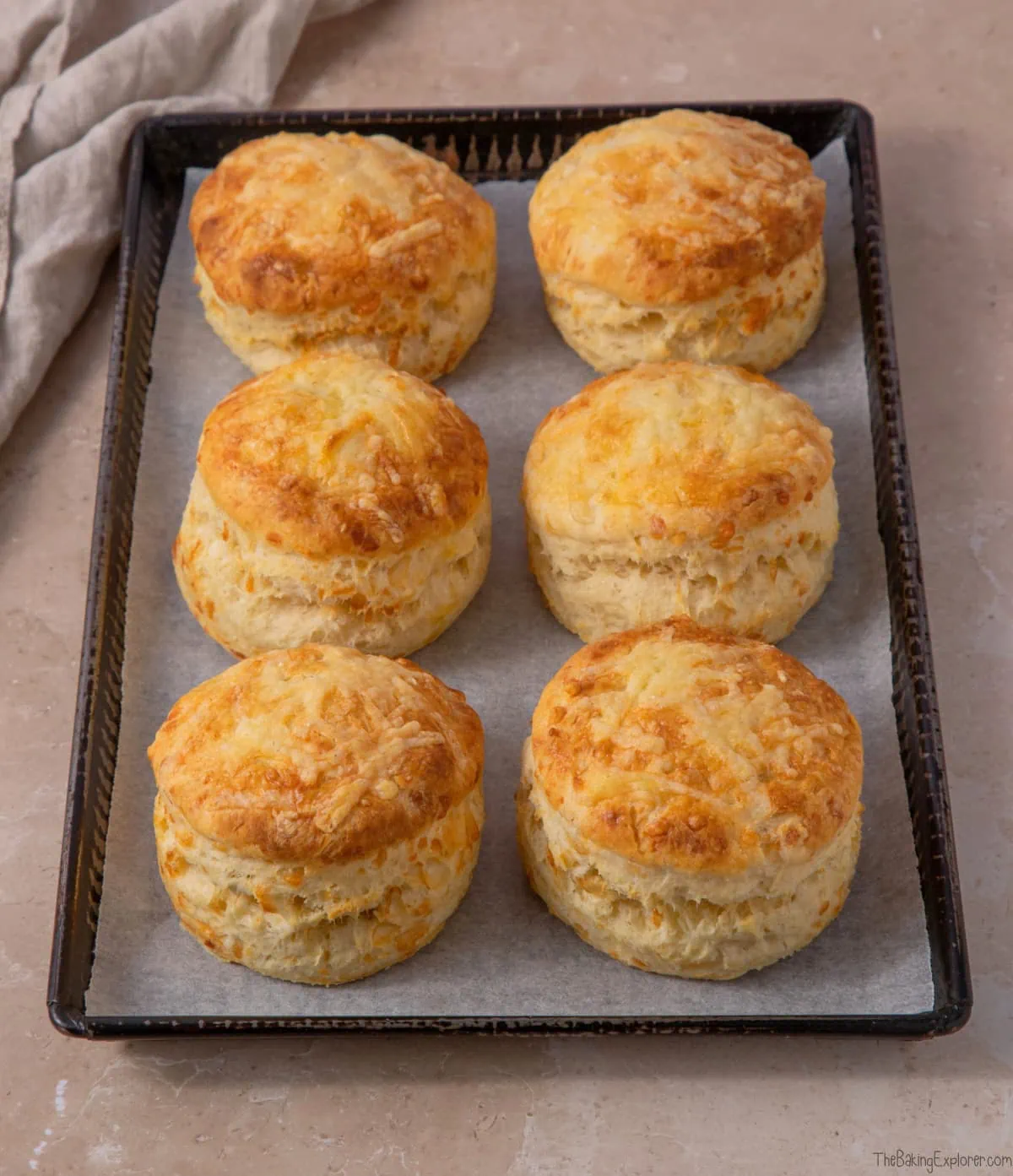
Should you make scones with butter, margarine or a baking spread?
Butter is the best option for flavour and richness in your scones. However, you can absolutely make scones using a margarine or baking spread. I've made them many times using Stork and gotten great results. You may get a wetter dough when using baking spread or margarine, so you might not need as much milk.
Can you make scones with plain or all purpose flour?
Yes, if you want to make them with plain or all purpose flour, you will need to add extra baking powder as self raising flour contains baking powder (and a little salt). I recommend using 3 ½ teaspoons baking powder for this recipe if you use plain or all purpose flour. You may also wish to add a pinch of salt. When measuring the baking powder, please use proper measuring spoons for the best results, do not use a regular teaspoon that you would stir coffee with for example.
How should you cut out scones? Do they have to be round?
Traditional English scones are round, whereas American scones tend to be triangular. I find that circular scones rise more evenly, and they feel like the natural shape for afternoon tea (although I am British so I would say that!) If you want triangular scones, pat the dough out into a circle and cut into triangles like you're cutting a pizza.
How many scones does this recipe make?
It depends on the size of cutter you use and how thickly you pat out the dough. I use a 2.5 inch cutter, and the dough is around 2cm thick, and I get 10 scones out of this recipe. I find this is an ideal amount because scones don't keep very long and are better fresh. If you want to make more scones, you can double or even triple the recipe.
Do you need an electric mixer to make scones?
No, scones are very easy to make by hand with minimal equipment. Blending the cold butter into the flour can be done with a food processor to speed up the process.
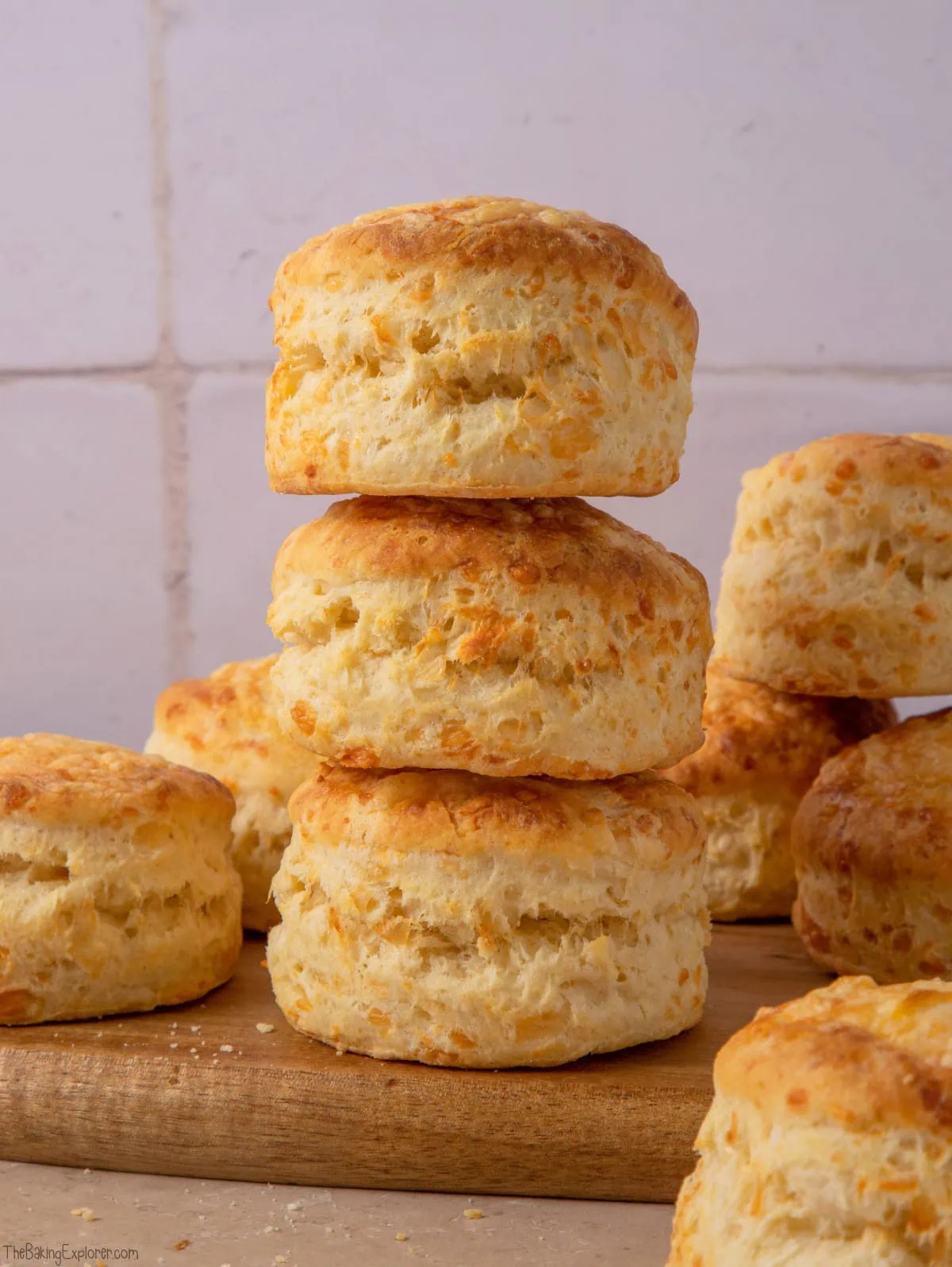
How should the scones be stored and how long do they last?
Scones are always better fresh, in fact about 10 minutes after they've come out of the oven is the perfect time to enjoy them. They're super fresh, lovely and warm! Once they're fully cool, you can store them in an airtight container for 2 days, and you can also freeze them for up to 3 months. Freeze them in a freezer bag, airtight container or well wrapped in cling film.
Can the scones be made dairy free or vegan?
Unfortunately this recipe is not vegan or egg free. Once I develop a vegan scone recipe, I will share it here. This recipe can be made dairy free if you replace the milk with a dairy free milk (I like to use unsweetened almond milk), use dairy free butter (I recommend the Stork baking block or Flora Plant block) and dairy free cheese.
Can these scones be made gluten free?
Yes! Replace the self raising flour with a gluten free self raising flour blend, make sure the baking powder you're using is gluten free, and add ¼ tsp xanthan gum. If you can't find a gluten free self raising flour blend, you can use a gluten free plain flour blend, but you will need to add an additional ¼ tsp xanthan gum and 3 ½ tsp gluten free baking powder.
What can you serve with Cheese Scones:
- Butter
- Marmite
- More cheese!
- Chutneys and pickles
- Soup - great for dipping chunks of cheese scone into
- Make the scone into a sandwich and fill with your favourite sandwich fillings
- Serve alongside a stew, they're great for mopping up the gravy
More tips for making the Cheese Scones:
- Push the cutter straight down into the dough and do not twist it, twisting it can affect the rise of the scones.
- When you glaze the top of the scones with the egg, make sure the egg doesn't drip down the sides. This can affect the rise of the scones.
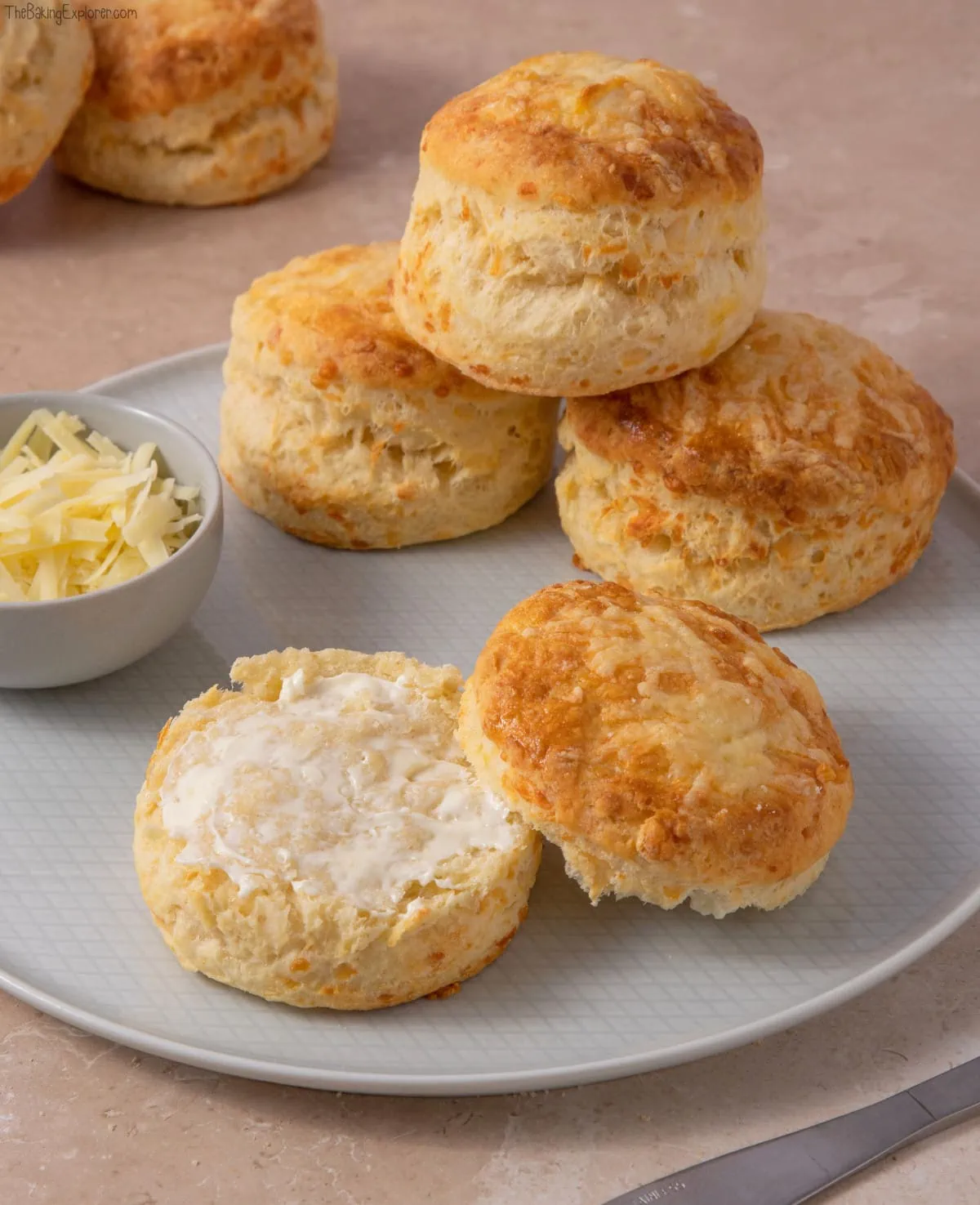
Troubleshooting
If you have any questions about this recipe, or if something went wrong and you need help, please use the comment form below and I will get back to you. You can also get in touch with me on my Twitter, Instagram or Facebook. I'd love to hear from you!
Recommended equipment & ingredients
- Mixing bowls
- Baking trays
- Cooling rack
- Kitchen scales
- Round cutters
- Measuring spoons
- Silicone Brush
- Cheese grater
I earn a small amount of money if you buy the products after clicking on the links. You will not be charged anything extra for this. Thank you for supporting The Baking Explorer!

More scone recipes...
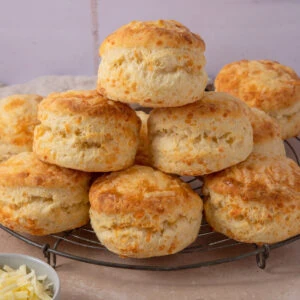
Cheese Scones
Ingredients
For the scones
- 450 g Self raising flour
- 1 ½ tsp Baking powder
- ½ tsp Salt
- 1 tsp English mustard powder or cayenne papper, or paprika (optional)
- 85 g Butter unsalted, cold
- 150 g Strong cheddar cheese grated
- 220 ml Milk whole or semi-skimmed
- 1 Egg large
For glazing/topping
- 1 Egg medium
- 25 g Strong cheddar cheese grated
Instructions
- Pre-heat your oven to 200C Fan/400F/Gas Mark 6, and line a baking tray with baking paper
- Stir the self raising flour, salt, baking powder and if using, the mustard powder or other spices, together a mixing bowl
- Add the butter and rub it into the flour with your fingers, a pastry blender or a fork ,until it resembles breadcrumbs. You can also use a food processor to do this step
- Add the cheese to the flour mixture and stir it in
- In another bowl, or in a jug, whisk together the egg and milk. Add it to the flour mixture
- Bring the mixture together to form a dough, being careful not to overwork or knead it too much
- Using your hands, pat it out into a flat disc shape onto a clean work surface (or a silicone mat) dusted with flour. Aim for it to be about 2cm thick. Cut out the scones using a round cutter, size of your choice (I used a 2.5" one). Push the cutter straight down and do not twist it
- You will need to re-pat out the dough to use it all up
- Place the scone rounds onto the baking tray, brush them with the beaten egg and sprinkle with the cheese
- Bake for 12-14 minutes or until golden brown and risen. Remove from the oven and allow to cool, you can eat them warm or cold
- Store in an airtight container and eat within 2 days. They can also be frozen
Video
Notes
- I prefer to use unsalted block butter for scones, you can use a baking spread, but butter has a nicer flavour. Baking spread can also make the dough wetter due to it's higher water content.
- The best cheese to use for these scones is a strong cheddar, so the cheese flavour really comes through. You could also use red leicester, or a half and half mix.
- You can use either whole milk or semi-skimmed milk for this recipe. Or a plant based milk, like oat milk for example.
- I used a 2.5" round cutter and got 10 scones from this recipe.
- Although I provide cup measurements, I highly recommend weighing your ingredients out using digital kitchen scales. It is the most accurate way to measure ingredients and will ensure the best results. Digital scales are very low cost and can be purchased for around £12 ($16.50) .
- For teaspoon (tsp) and tablespoon (tbsp) measurements, please use measuring spoons and not the type of spoons you eat with. Again this will ensure accuracy and provide the best results.














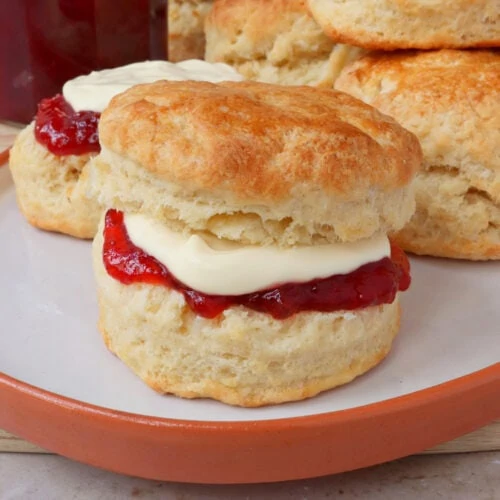
Ana ( JoFi’s Bakes)
Made these for the first time today and they did not disappoint.
Super easy recipe and the softest, most delicious cheese scones!
thebakingexplorer
Thanks so much, I'm so happy you liked them!
Jayne
These were so easy and really delicious. I did need a touch more milk but these are going to be my go to recipe for savoury scones, A nice exterior and so light and fluffy inside, thank you..
Lisa
I made these last week and served them warm from the oven with chilli jam, they were super easy to make and delicious . They were a sure hit and I will definitely be making them again .
thebakingexplorer
The chilli jam sounds amazing, I'm so pleased you enjoyed them!
Jayjay
Could you use buttermilk inpl plain of normal milk in the recipe, thanks.
thebakingexplorer
I've not tried this but I don't see why not - please let me know what happens if you try it